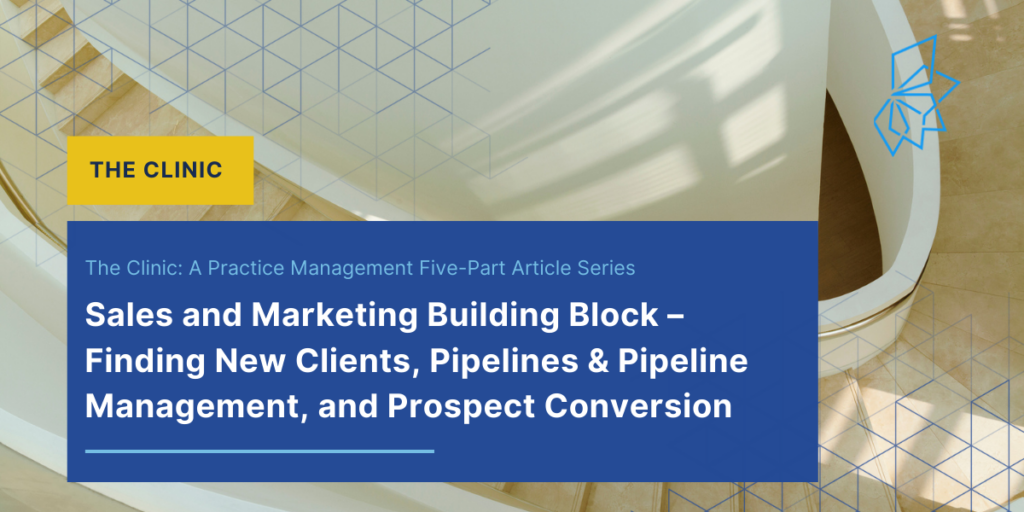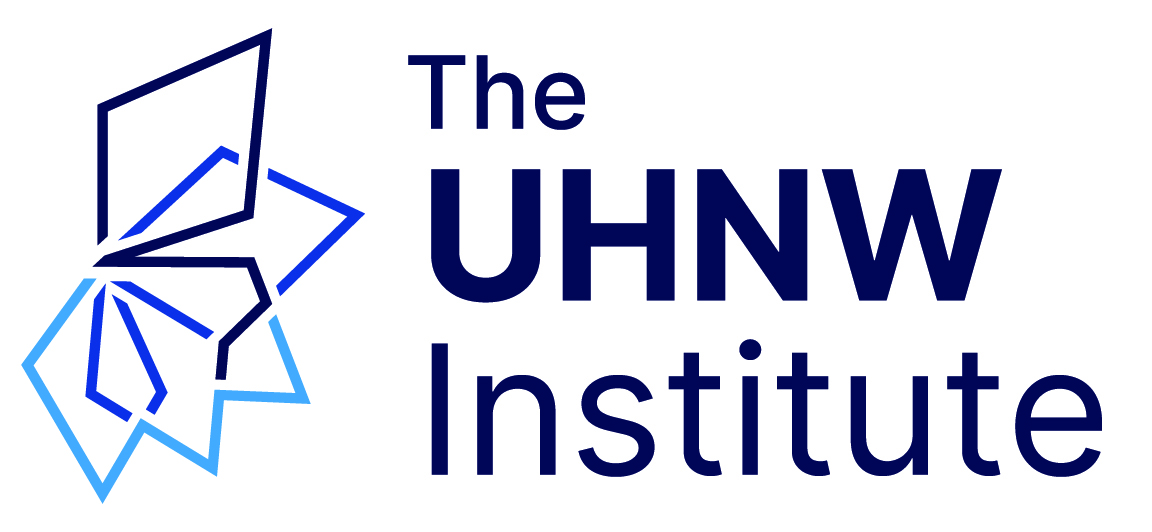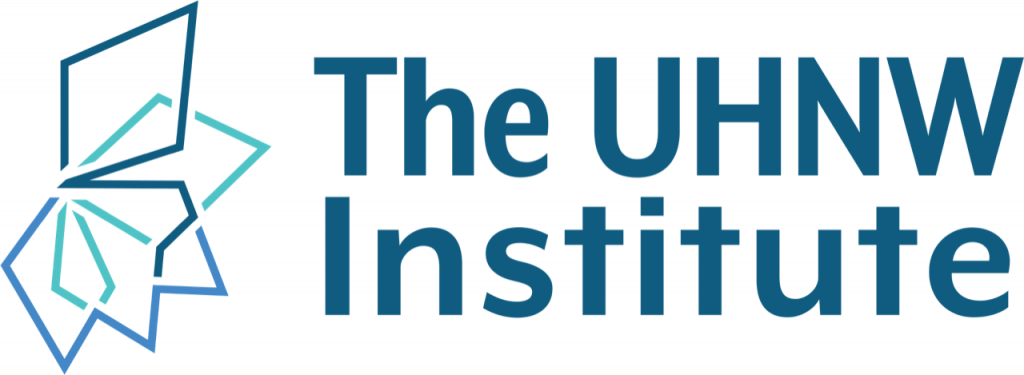
Practice Management: Sales and Marketing Building Block – Finding New Clients, Pipelines & Pipeline Management, and Prospect Conversion
This third article of “The Clinic”, a five-part series aligning with thought leadership and lessons learned from our bi-monthly Practice Management Clinics, concentrates on the May 8th Sales and Marketing PMC, featuring Brian Hughes, President of Eton Advisors.
We invite members to contribute their thoughts, insights and suggested resources on the topics listed below by participating in the Institute Community Forum discussion on Sales and Marketing here. Information and materials from this session are available to members, here.
To learn more about our ongoing Practice Management Clinic sessions click here.
Please note: Topics, recommendations, lessons learned and best practices described below came from the discussion of industry professionals with expertise who have worked in the field for at least two decades. The information is shared for informative purposes only; we make no representation or warranty of any kind, express or implied, regarding the accuracy, adequacy, validity, reliability or completeness, and your reliance on any information is solely at your own risk.
Practice Management: Sales and Marketing Building Block – Finding New Clients, Pipelines & Pipeline Management, and Prospect Conversion
By: Richard Joyner, Managing Director at AlTi Tiedemann Global, member of the Advisory Board of the Ultra High Net Worth Institute, and member of the Practice Management Committee
Every advisory firm serving UHNW families faces issues around growth at one time or another. Advisors, particularly the most senior and experienced advisors who lead client relationships, stay very busy managing those relationships and delivering high touch, technical services. There are always so many things competing for the advisor’s time – calls to return, client meetings, reviewing reports and analysis, and team members to coach and train. So where do the new clients actually come from? And if a firm wants to continue to grow, what should they do?
Client Acquisition Strategies
The first question is pretty straightforward. How does the firm find new clients today? Does the firm require that advisors use a portion of their time to find new clients, or does the firm utilize professional business development officers? Does hiring business development professionals enhance the firm’s success?
Historically, most new client acquisition work is done by advisors, but there are obstacles. An advisor may not have developed strategies for bringing in new clients consistently. And as the advisor succeeds and gets busier, there is simply less time to look for new clients. There may be a shortage of successful referral relationships (centers of influence), and the advisor may be hesitant to ask clients for referrals. Why do advisors hesitate? The most likely reason is fear – fear of damaging a current, successful, client relationship.
One solution to consider is to hire professional business development (BD) officers to ensure a consistent focus on new clients. However, developing new business in the ultra high net worth market is not easy. More than ever, clients know what they are looking for and have very high expectations for professionalism, expertise and knowledge. They want a consultative approach, not someone to “sell” them. And then, if a BD officer is successful and brings a new client to the firm, how does a firm prevent the client from feeling like a victim of a “bait and switch?” The family spends time with the BD officer, develops a good relationship, then is handed off to a new service team. The family may not have even met the service team until agreeing to become a client of the firm.
Some firms address this issue by asking BD officers to remain part of the client engagement as a senior advisor, at least for a period of time. In that way, they can help ensure the client is actually receiving what the firm committed to deliver. In effect, the BD officer becomes a client “advocate.”
If the firm relies on relationship managers to find new clients, perhaps a different approach could make the process easier. For example, a client advisor looking for introductions (not referrals) from clients can set a separate, standalone meeting for the express purpose of gathering feedback. If done properly, the firm can get candid, detailed feedback on its services and approach, and if the feedback is positive, the advisor can expand the conversation to remind the client of all the firm’s services and the value it delivers. The advisor can explain that to be successful, the firm needs to continue to grow. Growth helps the firm hire and retain great people, invest in new technology, and expand its service offerings. Then the advisor can explain that while the client can expect the growth to be paced and deliberate, the firm has consistently found it is most successful with families that are referred by the clients who understand what the firm does.
Centers of influence (COIs) are another source of consistent referrals and clients. Many advisors have a long list of COI contacts, but the key is to focus on some number of COIs with whom the advisor can develop a deeper and more meaningful relationship. It is important to gain “mindshare” with those COIs. That means more than just a periodic lunch or a round of golf or other social activity. It means that the advisor has thoughtful, meaningful and regular contact with the COI. The advisor’s efforts should demonstrate that the advisor understands the COIs business, how the COI achieves success, and that the advisor is also willing to make referrals. The COI needs to know the advisor’s business, too. Can the COI explain clearly how the advisor firm creates value for the prospect? Success comes from true partnership, where the two parties are committed to one another’s success.
Most advisory firms have learned the importance of defining the characteristics of their ideal clients, but it is equally important to define an ideal COI. Be clear about the traits you and your firm think will bring success. Ideal COIs must have strong relationships within their own networks, and they must be willing and able to offer you enthusiastic referrals. If your current COI relationships are not generating new business opportunities, it may be time to rethink your list of high priority COIs.
Ultimately, for any firm that works extensively with COIs, any actual business opportunities come from “relationship capital.” What you want from a COI is more than just a casual introduction to a prospect. You want the COI to tell the prospect who you are, all about you, why they think you would be an ideal fit, and why the prospect should hire you. It is very powerful when a COI is willing help “transfer trust” they have with the prospect to you. This goes way beyond a warm introduction. It is when a COI sets up the meeting then “bangs the table” when they tell the prospect why they must hire you. If you can get referrals like that, you will have a very high success rate.
There are other ways to generate new business, of course. Some advisors simply have a very broad and deep personal network of personal clients. And some firms with thoughtful strategies are experiencing growing success with digital marketing strategies.
Pipeline Management: Best Practices
For any firm to succeed with business development consistently, over time, it is very important to have a process for managing the firm’s prospect pipeline. Any firm that wants regular growth must invest time and energy in this process. It can be tempting to allow this process to be ad hoc and informal, but the result will almost always be that it becomes inefficient and ineffective. Given the challenges most advisors have around time, it seems logical to do everything possible to prioritize the firm’s efforts on the best opportunities – those that are most likely to turn into revenue the fastest.
So, what level of prospecting activity is required to generate a maintain a consistent and substantive pipeline of opportunities? It is hard to say, but each firm’s experience tracking its own business development activity and continuously evaluating what works and what doesn’t over time will provide helpful clues.
How much time should it take to manage the pipeline process as a firm? As with any other business process, it depends. Pipeline management is an important activity because it requires advisors to prioritize their pursuits. It helps them gain a better understanding of where they are succeeding (or failing) in the business development process. From a financial perspective, it also allows the firm to predict revenues more accurately and assess their capacity needs more realistically. Over time, firms who invest the time to do it well find the process very meaningful.
If a firm meets regularly to discuss its pipeline, there are some ways to make the meeting as effective as possible. First and foremost, everyone needs to be fully prepared in advance. The meeting need not last more than 30 minutes, and the focus of the meeting should be on the challenges and obstacles to getting new prospects over the finish line and converting them to paying clients. The meeting should not allow time for storytelling about how the referral came up or the current status of the pursuit – those discussions might be interesting, but they do not create results. The best outcomes will occur with a laser focus on advancing the opportunities that can be closed most quickly.
Other suggestions for the pipeline management process include a thorough and thoughtful job of categorizing prospects into buckets that are meaningful in the firm’s decision-making process. Understanding which prospects are on the “finish line” and ready to become clients versus the ones that might be great prospects in a year or two is critically important. A firm might create buckets for prospects that are ready to make a decision, for prospects that are in various stages of the sales cycle and prospects the firm should stay in touch with but which do not warrant a great deal of time or energy investment now. Decisions can then be made with a clear view as to what opportunities will likely create revenue in the near-term, which ones have run into obstacles, and which ones do not require anything but staying in touch.
One additional note is to keep the firm’s attention on closing new client opportunities all the way through negotiating client agreements and onboarding. Many firms think they have won a new engagement when the client commits, but there are many obstacles that can derail the onboarding process. It is very important to maintain the emphasis getting to revenue as soon as possible.
It is helpful to maintain a high level of business discipline in the pipeline management process. Allowing the process to be too loose – by being too optimistic and padding the pipeline or not having clear guidelines about what should or should not be reported – can really compromise the quality and value of this process. Applying consistent discipline makes it easier to achieve success.
Creating and managing a COI pipeline can be as valuable as a prospect pipeline. If a firm defines its “ideal” COI, the pipeline can help the team monitor what is working and prioritize its efforts to maximize the success of its COI contacts. This likely requires creating an effective COI discovery process, as well. Learn all you can about all of your firm’s high priority COIs – what they do, how they do it, how they create value for their clients, and how you can help them be more successful.
Prospect Conversion
If what you are doing is successful, and you generate a steady flow of prospects, it is important to think about the process of converting those opportunities into new business and revenue for the firm. The most important thing to remember is to give the prospect the opportunity to articulate their decision-making process. Eliminate as much of the guesswork as possible and address everything the prospect needs to make their decision. Open-ended questions work very well. Questions like “how do you go about making this decision,” or “what are the must haves” and “nice to haves” can provide added clarity.
As you go through the process, continue to dig deeper into what is and is not important. Focus your efforts on the decision factors that are important to the prospect and build your proposal around those factors. Try to gain as much agreement about what the prospect wants and needs before submitting a proposal. This helps eliminate surprises for the prospect, and gives you the greatest probability of acceptance.
Many advisors are reluctant to spend the time or make the effort regularly to find new clients and grow the business. Growth – organic growth – is the lifeblood of any successful business. It is very clear that by adding discipline and investing time, an advisor can substantially improve the overall results.

